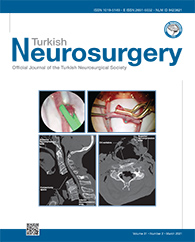MATERIAL and METHODS: We retrospectively reviewed our patients with MM. The rate of kyphosis, mean angle of progression and mean angle of surgical correction were evaluated. Surgical correction was achieved with the same technique in all patients; kyphectomy, short segment instrumentation with plate system and long segment instrumentation with screw-rod system.
RESULTS: A total of 14 patients were treated surgically and the mean age at the surgery was 39 months. The incidence of kyphosis rate was %21 in this study. The mean angle of kyphosis was 85.8°. Average angle of progression was 15.7° whereas it was 6.3° degree in patients whose kyphosis angle ?90 and >90 degree, respectively, at birth. 14 patients were treated surgically and the mean age at the surgery was 39 months. The mean angle of correction of kyphosis was 86 degree. The most common complications were wound dehiscence and cerebro-spinal fluid leak. One patient died 3 months after surgery, and one patient was reoperated due to pull-out of screws.
CONCLUSION: Effective surgical correction of kyphosis in MM patients can be achieved with the described surgical technique even in younger ages. Prospective studies in larger study population are necessary for more accurate definition of natural history of kyphosis in MM patients.
Keywords : Myelomeningocele, Kyphosis, Spinal Deformity, Kyphectomy




